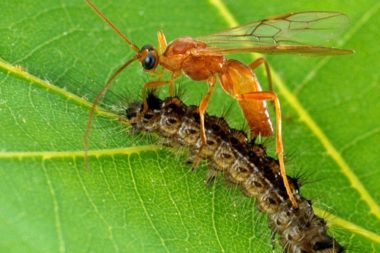Threats of Pesticide Addiction
Following World War II, many farmers suddenly turned to DDT, the first modern pesticide. With great fanfare, it was hailed as a miracle discovery, protector of crops and eradicator of malaria. But such hopes were soon dashed.1, 2
A nasty surprise awaited. Our new chemical friends didn’t discriminate. They attacked all living things, including us. Furthermore, they often aided our worst enemies! Prior to the discovery of modern pesticides, harvests were steadily improving. Then they took a nose dive. Over the next 50 years, crop losses nearly doubled, and farmers were forced to use more than 10 times as many pesticides just to prevent even worse losses. In the U.S. alone, we now use a billion pounds (500,000,000 kilos) of pesticides annually, including more than 600 types.1 A bit late, we’re discovering the danger.
Planning a Better Future
The good news is that it’s not too late to begin minimizing our addiction to pesticides. Numerous examples demonstrate that pesticide use could be reduced by at least 50% without reduction of crop yields or standards.3 In fact, Sweden has reduced pesticide use by 68%, without reduction of either, and has simultaneously reduced public pesticide poisonings by 77%. A similar goal has been recommended for the U.S.1
Eating organic can save your life as well as the creatures we love. Organics are tastier and healthier.
Getting Started
- When possible, eat organic. It’s far less costly than getting cancer or dementia and more effective than legislation in redirecting agricultural use away from toxic pesticides.
- For roaches and ants indoors, treat safely with nontoxic remedies like Borax powder.
- Encourage native vegetation and habitats in yards and farm fence rows.
- Rotate crops.
- Put up bat and bird houses.
- Never permit aerial spraying or fogging for mosquitoes.
- Drain clogged rain gutters, flower pots and other temporary sources of standing water. In permanent ponds, introduce mosquito-eating fish. Understand that attempts to eliminate all mosquitoes are impractical and likely counterproductive in the long run.
- Whenever possible, support small, local growers.
Bats: Masters of Nocturnal Pest Control
Many of our most feared insect pests are nocturnal and preyed upon by bats. These include disease-carrying mosquitoes4,5 and a wide variety of the world’s most costly moth,5 beetle,6 and plant-hopper pests.7,8 In the U.S. alone, despite greatly reduced numbers,9 bats still are estimated to save farmers more than 22 billion dollars annually.10 They help protect major crops, from corn11 and rice12 to macadamia nuts13,14 and cocoa.15
In a controlled study in Michigan, northern long-eared myotis (Myotis septenrionalis) significantly reduced the numbers of ovipositing female mosquitoes.4 Also, a single northern bat (Eptesicus nilssoni) from Sweden has been reported catching more than 1000 mosquitoes in an hour.16 A colony of 30,000 southeastern myotis (Myotis austroriparius) in Florida was estimated to capture approximately 15 tons of mosquitoes annually.17
Left: An Egyptian slit-faced bat (Nycteris thebaica) is one of several South African bat species that preys heavily on green stink bugs, costly pests of macadamia nut orchards. Macadamia farmers surrounded by natural, bat-friendly vegetation report few pests. Middle: One little brown myotis (Myotis lucifugus) can catch up to 1,000 mosquito-sized insects in a single hour. Right: A black woolly bat (Kerivoula furva) capturing an oriental leafworm moth in Taiwan. This is one of Australasia’s most costly crop pests. It attacks a wide variety of fruit and vegetable crops.
Brazilian free-tailed bats (Tadarida braziliensis) from Bracken Cave, Texas consume up to 100 tons or more of insects in a single night. Free-tailed bats (Chaerephon plicatus) from Khao Chong Pran Cave in Thailand consume enough white-bellied planthoppers to save local rice growers an estimated $300,000 annually.8
Free-tailed bats also can fly thousands of feet above ground to intercept migratory pests before they can deposit their eggs. And just one can easily catch enough migrating corn earworm, tobacco budworm, or armyworm moths in a night’s feeding to prevent them from laying thousands of eggs on a wide variety of crops, especially corn and cotton.5
Unlike small birds, night-flying bats can feed over open croplands without fear of attack from birds of prey. And because free-tailed bats can use tailwinds to travel at speeds approaching 100 miles per hour,18 aggregations of migratory insects can be hunted even over large, single-crop areas avoided by other insectivorous creatures.
Caves harboring great bat colonies are being disturbed and destroyed at alarming rates and are in urgent need of protection.19 Where caves of extirpated colonies have been restored and protected huge colonies have gradually rebuilt, giving hope for the future.20
Additionally, artificial roosts are rapidly growing in popularity and success, from small backyard houses to ones now occupied by hundreds of thousands of bats.20,21 Because bats often can be attracted to artificial roosts in locations where they are most needed,12and because they are more tolerant of human-altered landscapes than most insectivorous animals,9 they provide unique opportunities for helping with pesticide reduction.
Bat houses in yards and gardens can be especially useful, because many insects listen for bat echolocation sounds, terminating courtship or fleeing areas where bats are heard.22,23 They provide measurable results that can be a first step toward gaining farmer cooperation in protecting and reestablishing hedgerows and other habitats that help restore natural biodiversity, a first step in reducing pesticide dependence.24
Claims demeaning bat benefits typically come from those who profit most from promoting sale of pesticides or fear of bats to inflate public health research budgets.25 Bats are among nature’s most valuable allies in securing a safer, healthier future for humans.
Why Be Concerned About Overuse Of Toxic Pesticides?
How We are Losing the Race Against Insect Pests
Pesticide addiction is caused by what entomologists refer to as the pesticide treadmill. Insect pests rapidly evolve resistance, gradually forcing farmers to increase both the volume and toxicity of poisons to achieve the same results. Simultaneously, because predators of pests have much smaller populations and reproduce slower, they are more effectively poisoned or starved. Remaining pests then flourish in a largely predator-free environment.1,28
Moreover, honeybees and other pollinators essential to production of one-third of world crops are also killed, as are many insects needed to help keep pest species in check (like praying mantis, ladybird beetles, and wasps).1,29 Fifty percent of pest species have become pests only because pesticides killed their traditional predators.30
As early as 1979, the United Nations Environmental Program suggested that pesticide resistance ranked as one of the top four environmental problems of the world.1
New Chemicals to the Rescue?
Worldwide pesticide sales amount to tens of billions of dollars annually1, supporting almost unimaginable lobbying to make products seem safe and necessary.31Nevertheless, the facts are simple. Nature’s evolutionary processes are tough to beat, and attempting to do so can be extremely costly.28
Each time a new chemical combination or genetically modified product fails, we’re lured forward with claims of new discoveries. But they’re often high risk gambles. One of industrial agriculture’s biggest GMO crops, Bt corn, appears to have quickly backfired as rootworms became resistant within a few generations.32
When biodiverse landscapes are converted to large, single-crop areas (monocultures), they become extremely vulnerable to attack from insect pests with high reproductive rates.28 Natural predators, such as lizards, spiders, and a wide variety of predacious insects, even small birds, can no longer go there. Since the 1940’s between 500 and 1000 insect and weed species have developed pesticide resistance.33 Freed from natural predation, they can become a farmer’s nightmare. Biodiversified farming offers the best hope for both farmers and consumers.
No Magic Bullet for Mosquito Control
As history has repeatedly demonstrated, the short-term benefits of pesticide spraying for mosquitoes are far outweighed by long-term harm. DDT, the first miracle cure for mosquito problems, was later linked to serious human and environmental health problems.2,34
The pesticide Naled is currently sprayed (mostly from planes) on approximately 16 million acres of urban U.S. annually.35 It is an organophosphate neurotoxin that affects both insect and human nervous systems. It is not approved by the European Union.36 However, in the U.S., our CDC recommends it for mosquito control. 35
Experience refutes arguments for Naled use.37 An 11-year study in a central New York swamp documented that Naled spraying achieved short-term reduction of mosquitoes but did not detectably reduce Eastern Equine Encephalitis. Continued cases resulted in repeated spraying for 11 years, leading to a 15-fold increase in mosquito vectors!38
Bibliography
- Pimentel, D. 2005. Environmental and economic costs of the application of pesticides primarily in the United States. Pp. 229-252 in Environment, Development and Sustainability, Springer, NY.
- Carson, R. 1962. Silent Spring. Houghton Mifflin, Boston.
- Pimentel, D. L. McLaughlin, A. Zepp, B. Lakitan, T. Kraus, P. Kleinman, F. Vancini, W.J. Roach, E. Graap, WS. Keeton and G. Selig.1993. Environmental and economic effects of reducing pesticide use in agriculture. Agriculture, Ecosystems and Environment, 46(1993):273-288.
- Reiskind, M.H. and M.A. Wund. 2013. Experimental assessment of the impacts of northern long-eared bats on ovipositing Culex (Diptera: Culicidae) mosquitoes. Journal of Medical Entomology, 46(5):1037-1044.
- Wray, A.K., M.A. Jusino, M.T. Banik, J.M. Palmer, H. Kaarakka, J.P, White, D.L.Lindner, C. Gratton, and M.Z. Peery. Incidence and taxonomic richness of mosquitoes in the diets of little brown and big brown bats. J. Mammalogy, 99(3):668-674.
- Cutler, C., M. Betke, P. Federico, J.D. Frank, T.G. Hallam, J. Horn, J.D. Lopez Jr., G.F. McCracken, R.A. Medellin, A. Moreno-Valdez, C.G. Sansone, J.K. Westbrook, and T.H. Kunz. 2006. Front. Ecol. Environ., 4(5):238-243.
- Whitaker, J.O., Jr. 1995. Food of the big brown bat Eptesicus fuscus from maternity colonies in Indiana and Illinois. Amer. Midl. Nat., 134(2):346-360.
- Wanger, T.C., Darras, S. Bumrungsri, T. Tscharntke, and A.-M. Klein. 2014. Bat pest control contributes to food security in Thailand. Biological Conservation, 171(2014)220-223.
- Williams-Guillen K., E. Olimpi, B. Maas, P.J. Taylor and R. Arlettaz. 2016. Bats in the Anthropocene Matrix: Challenges and opportunities for the conservation of chiroptera and their ecosystem services in agricultural landscapes. Pp 151-186 in Bats in the Anthropoene: Conservation of bats in a changing world (C.C. Voigt and T. Kingston, eds.). Springer, New York.
- (Boyles, J.G., P.M. Cryan, g.F. McCracken, and T.H. Kunz. “Economis Importance of Bats in Agriculture.” Science, 332 (2011): 41-42.
- Maine, J.J. and J.G. Boyles. 2015. Bats initiate vital agroecological interactions in corn. PNAS, 112(40):12438-12443.
- Puig-Montserrat, X., I. Torre, A. Lopez-Baucells, E. Guerrieri, M.M. Monti, R. Rafols-Garcia, X. Ferrer, D. Gisbert and C. Flaquer. 2015. Pest control service provided by bats in Mediterranean rice paddies: linking agroecosystems structure to ecological functions. Mammalian Biology 80(3):237-245.
- Taylor, P.J., A. Monadjem, and J.N. Steyn. 2013. Seasonal patterns of habitat use by insectivorous bats in a subtropical African agro-ecosystem dominated by macadamia orchards. African Journal of Ecology, 51:552-561.
- Taylor, P.J, K. Bohmann, J.N. Steyn, M.C. Schoeman, E. Matamba, M. Zepeda-Mendoza, T. Nangammbi, and M.T.P. Gilbert. 2013. Bats eat pest green vegetable stink bugs (Nezara viridula): Diet analyses of seven insectivorous species of bats roosting and foraging in macadamia orchards. Southern African Macadamia Growers’ Association Yearbook 21.
- Maas, B., Y. Clough, and T. Tscharntke. 2013. Bats and birds increase crop yield in tropical agroforestry landscapes. Ecology Letters, 16:1480-1487.
- Rydell, J. 1990. The northern bat of Sweden: Taking advantage of a human environment. Bats, 8 (2):8- 11.
- Zinn, L., and S.R. Humphrey. 1976. Insect communities available as prey and foraging of the southeastern brown bat. Proc. 7th Annual North American Symposium on Bat Research, unpubl. paper presented at symposium.
- McCracken, G.F., S. Kamran, T.H. Kunz, D.K.N. Dechmann, S.M. Swartz, and M Wikelski. 2017. Airplane tracking documents the fastest flight speeds for bats. Royal Society Open Science, 3(160398):1-10.
- Furey, N.M. and P.A. Racey. 2016. Conservation ecology of cave bats. Pp. 463-502 In Bats in the Anthropocene: Conservation of bats in a changing world. Springer, NY.
- Tuttle, M.D. 2013. Threats to bats and educational challenges. Pp. 363-391 in Bat evolution, ecology, and conservation. Springer, NY.
- https://www.merlintuttle.org/2016/08/14/worlds-first-artificial-bat-cave/
- Acharya, L., and J.N. McNeil. 1998. Predation risk and mating behavior: the responses of moths to bat-like ultrasound. Behavioral Ecology, 9(6):552-558.
- Fenton, M.B. 2002. Sound wars: how bats and bugs evolve new weapons and defenses. Bats, 20(1):1-4.
- Crowder, D.W., T.D. Northfield, M.R. Strand, and W.E. Snyder. 2010. Organic agriculture promotes evenness and natural pest control. Nature, 466:109-112.
- Tuttle, M.D. 2017. Are Bats a Health Danger? Issues in Science and Technology, 33(3):41-50.
- Mearns, J., J. Dunn, and P.R. Lees-Haley. 2007. Cancer health effects of pesticides. Journal College of Family Physicians of Canada, 50(2):286-294.
- Mostafalou, S. and Mohammad Abdollahi. 2013. Pesticides and human chronic diseases: Evidences, mechanisms, and perspectives. Toxicology and Applied Pharmacology, 268(2):157-177. Invited Review Article.
- Dover, M. 1985. Getting off the pesticides treadmill. Technology Review, Nov/Dec, 52-63.
- Hallmann, C.A., M. Sorg, E. Jongejans, H. Siepel, N. Hofland, H. Schwan, W. Stenmans, A. Muller, H. Sumser, T. Horren, D. Goulson, and H. de Kroon. 2017. More than 75 percent decline over 27 years in total flying insect biomass in protected areas. PLOS ONE, 12(10):e0185809.
- Culliney, T.W. 2014. Crop losses to arthropods. Pp 201-225 in Integrated Pest Management. Springer, NY.
- http://foodbabe.com/2017/03/21/emails-epa-monsanto-now-revealed-contents-sickening/#more-27900
- Gassmann, A.J., J.L. Petold-Maxwell, E.H. Clifton, M.W. Dunbar, A.M. Hoffmann, D.A. AIngber, and R.S. Keweshan. 2013. Field-evolved resistance by western corn rootworm to multiple Bacillus thuringiensis toxins in transgenic maize. Proc. Natl. Acad. Sci. U.S., 111(14):5141-5146.
- http://www.panna.org/pesticides-big-picture/pesticides-101
- Cohn, B. A., M. La Merrill, N. Y. Krigbaum, G. Yeh, J-S. Park, L. Zimmermann, and P.M. Cirillo. 2015. DDT exposure in utero and breast cancer. J. Clinical Endocrinology & Metabolism, 100(8):2865-2872.
- https://www.cdc.gov/zika/vector/aerial-spraying.html
- http://eur-lex.europa.eu/legal-content/EN/TXT/HTML/?uri=CELEX:32012D0257&from=EN
- 2012. Aerial spraying public health hoax. PEEReview, Fall, pp. 1&12
- Howard, J.J., and J. Oliver. 1997. Impact of Naled (Dibrom 14@) on the mosquito vectors of Eastern Equine Encephalitis Virus. Journal of the American Mosquito Control Association, 13(4):315-325.




